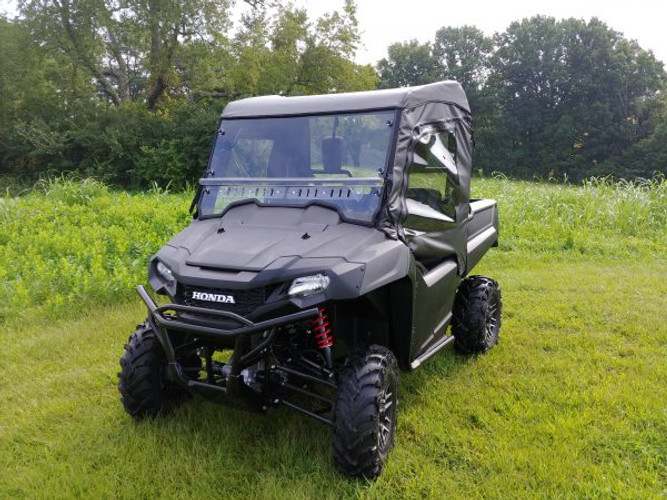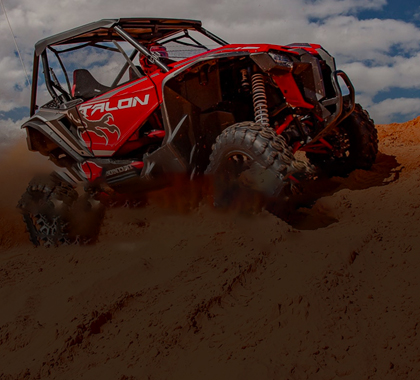Comparing UTVs: What Differentiates The Honda Pioneer
Feb 25th 2020
Comparing the Honda Pioneer to sport side-by-sides like the RZR or Can-Am X3 is like comparing apples to oranges. And if you use a work UTV as a sport vehicle, prepare for lackluster results that won’t live up to high expectations. Nevertheless, unlike the Defender, which is a pure utility vehicle, the Pioneer offers a nice blend of utility and sport. It might not be the fastest UTV on the market, nor is it the most powerful, but it can still hold its own against the big dogs — and even outperform some at specific tasks. So how exactly does the Honda Pioneer compare to other side-by-sides? Well, you’re about to find out!
Honda Pioneer Vs. Can-Am Defender
With 500cc, 700cc, and 1000cc options, one Honda Pioneer might differ greatly from another. Similarly, with the addition of aftermarket accessories, one can convert a stock Honda Pioneer into a vastly different machine. But regardless of the engine size and the accessories added, there are a few general attributes of a Honda Pioneer that distinguish it from other UTVs.
Both the Honda Pioneer and the Can-Am Defender are hard-working vehicles, and either will do you well on the farm, at the job site, or during a hunt. The two side-by-sides have comparable horsepower — around 72hp — but because of its V-Twin engine, the Defender actually has a good deal more torque. Nevertheless, despite being relatively equal in power, many have noted that the Pioneers’ delivery is smoother and the engine is much quieter.
While some riders take issue with Honda’s powder coating process, in general, if you take care of your Honda Pioneer, it will take care of you. With less issues and maintenance required than other utility side-by-sides, if you keep up with the periodic services (most of which you can do yourself) the Honda Pioneer will last for decades. It is not uncommon to see well-taken-care-of Honda Pioneers used on the farm or for daily commutes that have in excess of 20,000 miles on them.
Honda Pioneer Vs Polaris RZR
When compared to machines like the RZR, the fairy tale about the tortoise and the hare comes to mind. If you’re riding in a crew with popo's and canned hams, you might not be the first one in, nor the first one out, but you will be the one who makes it out no matter what. Sure Polaris might be “the way out”, but Honda is the way back.
In the woods, most drivers will be able to keep up with Razors and Can-Ams in the Honda Pioneer. In fact, they might actually lead the pack; not because the Honda Pioneer is faster, but rather, because it fits on tight trails and in between trees. Unless you’re drag racing, ripping around an off-road track with jumps and whoops, or using your UTV as an airplane or submarine, the Honda Pioneer will do just fine.
The RZR is a sport SxS, and was never intended for work. It has no bed space, a CVT transmission, and soft suspension. And the things that make it exceptional as a sport vehicle, also make it a poor choice for a work machine. Some might argue that if you want to ride every day, buy Honda, and if you sometimes want to ride and want to work on your rig every day, buy Polaris. This, however, is unfair. Even though machines like the RZR are notorious for shredding belts and breaking down, a lot of this has to do with the operator and maintenance on the machine. The best trail bike may well be a 50” RZR 900 trail, but for dependability, you can’t beat a Honda Pioneer.
Honda Pioneer Vs Polaris Ranger
One thing you’ll hear over and over again from Honda Pioneer owners is how dependable their bike is. Ride it nonstop year round and your liver will break down before the Pioneer does. Everything on the machine stays tight and doesn’t rattle around, throw on some tracks and you’ve practically got a tank. If reliability is what you need, the Pioneer is where it’s at.
One downside to the lower-cc Honda Pioneers is that they can be underpowered for some applications, and the cab of the 1000cc Pioneer is known to get quite hot due to the engine being located under the seat — which is not uncommon for UTVs. This isn’t a huge deal, though, for most riders. With a good flip-out windshield or some other simple mods, you can mitigate in-cab heat in the Pioneer. Plus, if you ride during winter, this might even save you from having to buy a UTV heater!
Another difference between the Ranger and the Pioneer is the latter’s I-4 wheel drive. While some see the I-4 wheel drive as a downgrade, preferring instead to just move a lever over and know that they’re locked in no matter what bind the wheel with traction is in, others love the I-4WD, and say it works great with uphill brake assist and different modes for shifting.
In Closing
While vehicles like the Kawasaki Mule or Kubota are hard to beat as heavy-duty farm cars, both are prohibitively slow, and the former has an inlet and manifold configuration that makes it prone to flooding. When it boils down to it, you have to ask yourself why you need a side-by-side and what you’ll use it for. If you want a race machine or something to rip on the dunes, a Honda Pioneer isn’t the best option. But if you want a dependable vehicle for a little work and a little play that won’t let you down, there’s no better choice than a Honda Pioneer.







